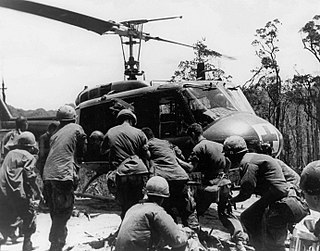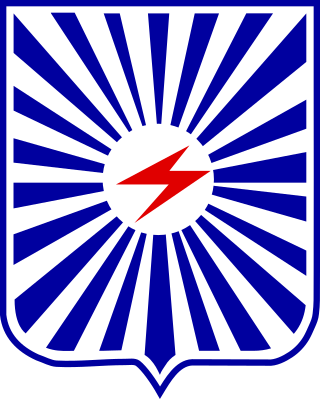
Operation Speedy Express was a controversial military operation conducted by the United States Army's 9th Infantry Division during the Vietnam War in the Mekong Delta provinces of Kiến Hòa and Vĩnh Bình. The operation, led by Major-General Julian Ewell, was part of counterinsurgency operations by the United States Armed Forces which targeted the Viet Cong (VC). U.S. forces aimed to interdict VC lines of communication and prevent Viet Cong personnel from establishing outposts in the region via the operation. The U.S. claimed the operation was successful in achieving its objectives, although the VC denied this and claimed the operation failed to stop their activities in the region.

The 18th Division was an infantry division in the III Corps of the Army of the Republic of Vietnam (ARVN). The U.S. Military Assistance Command Vietnam considered the 18th as undisciplined and was well known throughout the ARVN for its "cowboy" reputation. In 1975 the 18th was made famous for its tenacious defense of Xuân Lộc, the last major battle before the Fall of Saigon.
Operation Texas Star was a military operation of the Vietnam War that took place in Quảng Trị and Thừa Thiên Provinces from 1 April to 5 September 1970.

Operation Apache Snow was a joint U.S. Army and Army of the Republic of Vietnam (ARVN) military operation during the Vietnam War designed to keep pressure on the People's Army of Vietnam (PAVN) units in the A Sầu Valley and prevent them from mounting any attacks on the neighboring coastal provinces.

The 21st Division of the Army of the Republic of Vietnam (ARVN)—the army of the nation state of South Vietnam that existed from 1959 to 1975, was part of the IV Corps that oversaw the southernmost region of South Vietnam, the Mekong Delta. The 21st Division was based in Chương Thiện province, the southernmost province in the whole country, in an area dominated by jungles and swamps.
Operation Kentucky Jumper was a joint U.S. Army and Army of the Republic of Vietnam (ARVN) military operation during the Vietnam War designed to seek out and destroy People's Army of Vietnam (PAVN) and Vietcong (VC) units, interdict their base areas and infiltration routes and to support the Accelerated Pacification Program southwest of Huế, Thừa Thiên Province.

Operation Yellowstone was an operation conducted by the 1st and 3rd Brigades, 25th Infantry Division in northeast Tây Ninh Province, lasting from 8 December 1967 to 24 February 1968.

Operation Bolling was a search and destroy and security operation conducted during the Vietnam War by the U.S. 503rd Infantry Regiment in Phú Yên Province, South Vietnam from 19 September 1967 to 31 January 1969.

Operation Byrd was a security operation conducted during the Vietnam War by the U.S. 2nd Battalion, 7th Cavalry Regiment and the Army of the Republic of Vietnam (ARVN) 44th Regiment in Bình Thuận Province, South Vietnam from August 1966 to 1 December 1967.
Operation Nevada Eagle was a security operation during the Vietnam War in Thừa Thiên Province, that took place from 17 May 1968 to 28 February 1969.
Operation Iron Mountain was a security operation during the Vietnam War in Quảng Ngãi Province, that took place from 28 February 1969 to 28 February 1971.
Operation Frederick Hill was a security operation during the Vietnam War in Quang Tin Province, that took place from 18 March 1969 to 28 February 1971.
Operation Geneva Park was a security operation during the Vietnam War in Quảng Ngãi Province, that took place from 18 March 1969 to 28 February 1971.
Operation Washington Green was a security and pacification operation during the Vietnam War conducted by the 173rd Airborne Brigade in Bình Định Province from 15 April 1969 to 1 January 1971.
Operation Montgomery Rendezvous was a security operation during the Vietnam War conducted by the 101st Airborne Division in the area southwest of Huế in western Thừa Thiên Province, from 8 June to 15 August 1969.
Operation Barking Sands was a pacification operation during the Vietnam War conducted by the 1st Brigade, 25th Infantry Division that took place in Hậu Nghĩa and Bình Dương Provinces, lasting from 18 May to 7 December 1967.
Operation Fulton Square was a joint U.S. Army and Army of the Republic of Vietnam (ARVN) military operation during the Vietnam War to engage People's Army of Vietnam (PAVN) units in the lowlands of Quảng Trị Province.
Operation Quyet Chien, was a United States Army and Army of the Republic of Vietnam (ARVN) security operation during the Vietnam War that took place from 3 August to 31 November 1968.
Operation MacArthur was a United States Army military operation in the Central Highlands of South Vietnam from 12 October 1967 to 31 January 1969. The early phases of the operation encompassed the Battle of Dak To from 3 to 23 November 1967.
Operation Walker was a security operation conducted during the Vietnam War by the U.S. Army’s 1st Battalion, 503rd Infantry Regiment, 173rd Airborne Brigade in Bình Định Province, South Vietnam from 17 March 1968 to 31 January 1969.






